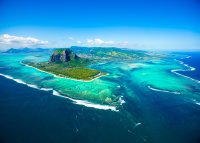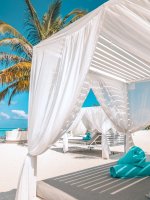Many writers have seen Curepipe as a dismal place. Mark Twain described it as ‘the nastiest spot on earth’. Michael Malim, writing in the 1950s book Island of the Swan, which caused a stir in Mauritius when it was published, said, ‘it seems drowned in some immemorial woe … stricken and inconsolable’. Mauritians themselves say there are two seasons in Curepipe: ‘the rainy season and the season of rains’. In fact, its annual rainfall matches London’s. It can be humid (‘God – the dankness of it all,’ wrote Malim) and temperatures as low as 7°C have been known there.
Perhaps its off-putting publicity is a campaign by the 80,000 or so residents to keep visitors away. They like their privacy. The avenues of the residential areas are lined with tall bamboo hedges, hiding the old, French-style, verandaed villas, wooden cottages and concrete, cyclone-proof houses. Streets have no names displayed, nor numbers on the houses, so only those familiar with the town will find their way around. It is not a welcoming place, with its grim market building of upturned culverts. The town seems to have no heart, either geographically or spiritually.
Its origins go back to the 18th century when it was a halt for travellers from one side of the island to the other. The usual story is that travellers stopped to smoke there, after which they would clean (cure) their pipes. However, its name is more likely to have come from a village in France.
The town hall overlooks a large compound of open square and gardens with the Carnegie Library and the former railway station, now used by the Central Water Authority, close to it. Close by are the Roman Catholic Ste Thérèse Church and the casino. The formal gardens, with lawns, flowerbeds and pathways, soften the administrative square and provide relief from the chaos of the open-air market nearby. The gardens include a memorial to Abbé de la Caille, the 18th-century surveyor of the island, and a romantic statue of Paul and Virginie, which is a bronze replica of Mauritian sculptor Prosper d’Epinay’s original. There are other listed national monuments in Curepipe, notably the grim stone building of Royal College, the island’s most prestigious school, and the war memorial in front of it.
It is tempting to wonder if the market building will ever be declared a national monument; it is certainly a unique feature of Curepipe’s skyline, with its ugly concrete pipes pointing upwards. The public toilets are closed for cleaning every day, 06.00–06.30, 10.30–10.45, 15.00–15.15 and 17.15–17.30. Be warned.
Curepipe is another popular town for shopping. As well as the usual discount clothing and duty-free jewellery shops, there are numerous handicraft outlets, including several model ship shops.
Curepipe has its own small botanical gardens to the southwest of the centre. The Forestry Department (% 675 4966) offices next door are where permission can be sought to visit the nature reserves of the interior.
The unsightly spread of Curepipe can be seen from the hills around the extinct volcanic crater of Trou aux Cerfs, at 650m above sea level. To get there from the centre of Curepipe, follow Sir John Pope Hennessy Street for about 800m, then turn right into Edgar Hughes Street. It is a short climb to the crater. The inside of the crater is wooded and it is possible to climb the 85m to the bottom. If you’ve been to Réunion you won’t be overly impressed by the crater, but the views are far-reaching. The panoramic view takes in the plateau towns and the mountains to the north and northwest, including the three cones of Trois Mamelles (629m). There is a meteorological station of futuristic design poised by the crater, as though mooning for its architectural soulmate, the market complex.
On the road from Curepipe to the motorway is the Millennium Monument, an 18m-high tower made of no fewer than 3,500 dark blue basalt stones, some six or seven million years old. It was erected by the Ministry of Arts and Culture to ‘celebrate the passage of the Republic of Mauritius into the third millennium’.
Getting there and away The bus station, which adjoins the market on Sir J H Jerningham Street, is the island’s busiest. Buses from Port Louis to Curepipe leave from the Victoria Square bus station. There are regular buses to Mahébourg, via Rose Belle and the airport. Buses also depart from Curepipe for Centre de Flacq, Souillac, Grand Bassin (via Bois Chéri) and Wolmar (via Flic en Flac). The best place to find a taxi is on Chasteauneuf Street. If you are in your own car, be aware that Curepipe is one of the towns where street parking coupons (bought at petrol stations) are required.
Tourist information There is no tourist office in Curepipe. There are some travel agents that may be able to help, provided your query is pretty simple. You could also try logging onto curepipe.org for information on the town.
Where to stay
Budget
A Auberge de la Madelon (25 rooms) Sir John Pope Hennessy St; % 676 1520; f 676 2550; e madelon[at]intnet.mu. Just north of the town centre. Simple but clean en-suite rooms with fan, TV & phone. There is a restaurant, small pool & Wi-Fi. $
Where to eat The Prisunic supermarket near the town hall stocks all the essentials. For cheap snacks, try the stalls around the market.
X La Nouvelle Potinière Hillcrest Bldg, 18 Sir Winston Churchill St, Curepipe; % 676 2648; ( for lunch Mon–Sat, for dinner Thu–Sat. Cuisine: French, crêpes, Creole, snacks. Claims to be the oldest restaurant in Mauritius. Has a sophisticated summery atmosphere. Reservation recommended. $$$
X Le Gaulois Dr Ferrière St, Curepipe; % 675 5674; ( 11.00–17.00 Mon–Sat. Cuisine: Creole, French. Great for people-watching because of its corner location on the road leading to the post office & bus station. Table d’hôte & à la carte menus. Plenty of plastic but clean. $$
Other practicalities
Communications The post office is near the market and offers poste restante and internet access. Internet access is also available at the cybercafé behind the Carnegie Library.
Money and banking Banks, including branches of Barclays, HSBC and Mauritius Commercial Bank, are found on Royal Road, in the centre of town.














